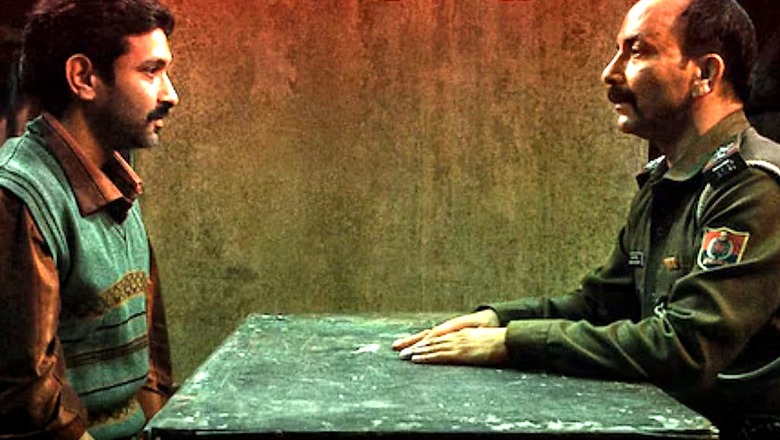
views
(Disclaimer: The following review contains details about sensitive and disturbing themes, including murder, sexual violence and cannibalism. Viewer discretion is advised.)
Sector 36 Movie Review: Spine-chilling, gut-wrenching and blood-curdling. That’s what Sector 36 is in a nutshell. Loosely based on the 2006 Noida serial murders, also known as the Nithari case, the Aditya Nimbalkar directorial is a nuanced, compelling and petrifying portrayal of the havoc a tormented childhood can wreak. However, that’s no justification for the atrocities inflicted on innocent souls. The film opens in 2005 in Delhi, where a house help named Prem Kumar—clad in his master’s velvet robe—lies on the sofa watching Sab Banega Crorepati.
The film opens in 2005 in Delhi, where a house help named Prem Kumar, clad in his master’s velvet robe, lounges on a sofa, watching Sab Banega Crorepati. Frustrated by how educated contestants fail to answer questions he knows the answers to, he finishes his meal, cleans up and retires to his bedroom. Before bed, he casually calls his pregnant wife back in his village. Then, in a haunting moment, he goes to his washroom to dispose of a schoolgirl’s dead body, sending a chill down the viewer’s spine. This sets the mood for the disturbing narrative that follows.
Prem works at the mansion of businessman Balbir Bassi. Gradually, the film reveals that Prem is not only a serial killer but also involved in human trafficking and organ trading. He is a necrophile and a pedophile who preys on children from a nearby slum. His criminal activities are abetted by his partner-in-crime, Chote Lal, a hospital compounder.
We are then introduced to sub-inspector Ram Charan Pandey, who brushes off locals reporting missing children from the slum. However, when Prem kidnaps Ram’s own daughter, he becomes determined to take these cases seriously. The film takes off from there, with tension building as Ram investigates the disappearance of Chumki, a sex worker often seen at Bassi’s mansion.
At 2 hours and 4 minutes, Sector 36 is a fast-paced ride that never slows down. It’s filled with dark, uncomfortable and claustrophobic moments that make you gasp, nudging you closer to the edge of your seat. The long interrogation scene between Prem and Ram is particularly gripping, with close-up shots of Prem that amplify his repulsiveness and nonchalance. His lengthy monologue is punctuated by Ram’s shocked interjections, ensuring you can’t take your eyes off the screen even for a moment.
Another sequence that lingers with you for its subtext and symbolism is the one where Ram, dressed as Raavan for a skit in the Ram Leela, becomes an embodiment of the mythological villain. Chumki’s father accuses him of indifference to the pain of a father who has lost his daughter. Ram, in character as Raavan, defends his apathy by saying he can’t manage the problems of 1,50,000 Rajiv Camp residents. Moments later, when his own daughter goes missing, he chases Prem, who is now wearing a Raavan mask, through the dark alleys of the city. This metaphor-laden scene, echoing Ram’s battle with his inner demons and his sinister nemesis, deserves high praise.
The director, Aditya, skillfully portrays Prem as a menacing predator through an objective lens. While we catch glimpses of Prem’s troubled past, it never evokes sympathy for his horrific deeds. During a key interrogation scene, Prem explains why he became a cannibal and his urge to kill children. The complexity of his character is shown, but the film never invites us to empathise with him for his twisted psyche.
Aditya also explores broader themes such as migration, the class divide and the relentless power struggles that crush the economically oppressed. The stark contrast between Sector 36 and Rajiv Camp is visually striking. While Sector 36 is shrouded in a gloomy gray, Rajiv Camp is portrayed with black undertones, representing both the physical grime and the social discrimination its residents endure.
The contrast between Ram and Prem is also cleverly drawn. On one side, Prem gruesomely dismembers his victims, splattering blood, while on the other, Ram lovingly wraps his daughter in a red saree to take her to witness Raavan Dahan—a symbol of good triumphing over evil. These scenes intercut with flashes of Durga Puja, where the goddess vanquishes Mahishasura, reinforcing the triumph of the divine feminine over evil.
The exceptional writing is further elevated by stellar performances from Vikrant Massey and Deepak Dobriyal. Vikrant delivers a chilling portrayal of the unstable, maniacal Prem, bringing immense terror and rage to the screen. His performance is a standout, playing a character who embodies a murderer, rapist, necrophile and cannibal, all in one.
The scene where Prem talks to a kidnapped boy and suggestively touches his lips is genuinely traumatic. Vikrant fully immerses himself in the role, making it one of the finest performances of his career, comparable to his turn in 12th Fail. Deepak Dobriyal, as Ram, complements him perfectly, portraying the transformation from a laid-back cop to a driven reformer, determined to bring Prem to justice.
The nuance in Deepak’s performance, especially in scenes where his wife calls him out for failing to protect their daughter, and his battles with his superior officer, DCP Jawahar Rastogi, add depth to his character. Ram’s evolution, based on Newton’s Law of Motion—”For every action, there’s an equal and opposite reaction”—drives his decisions and actions.
While the climax may be predictable, it doesn’t take away from the storytelling. In a time when the entitlement of sexual predators is under scrutiny, Sector 36 feels more relevant than ever. It’s bold, audacious and deeply poignant. It stands out in a sea of murder mysteries and crime thrillers. Let it send chills down your spine, curdle your blood, and wrench your gut, because, as Cesar A. Cruz said, art should disturb the comfortable.




















Comments
0 comment